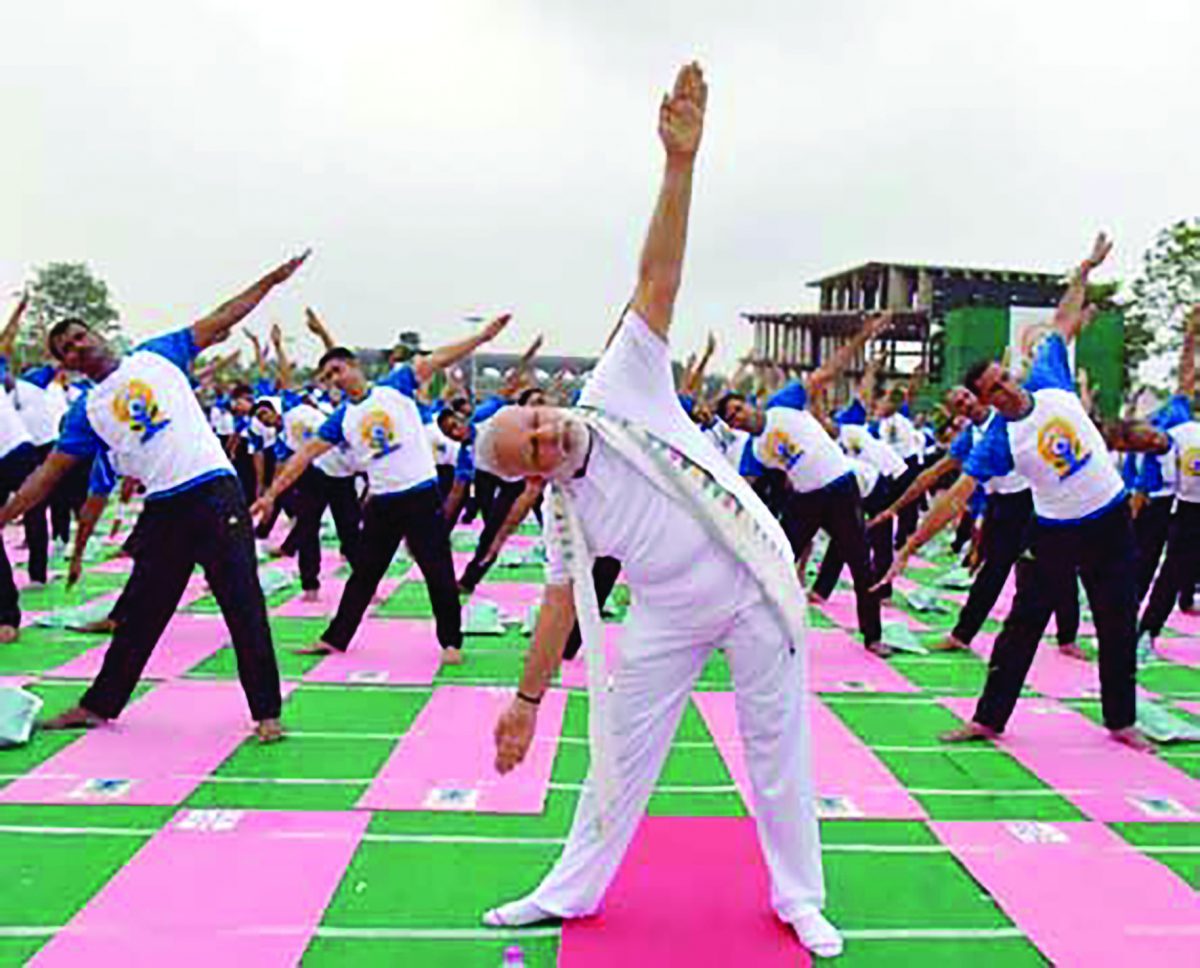In contemporary times, with an increasingly fast-paced lifestyle and a modern approach to healing tactics, we unknowingly keep accumulating micro assaults to our immune system without allowing our body to address them. Here’s how the ancient albeit simple practices of yoga can be utilized to boost our immunity, lead a healthier life and so much more

The human body to a great extent is a self-regulating, preserving, repairing and maintaining entity. Nature has designed the human body with an inherent capability to heal and provided the natural laws of healing are allowed to operate, our health is in its entirety, a natural outcome of all the encounters we have in life. This healing capacity that we are endowed with is called vitality or immunity. Our body has a self-reliant system of protecting its tissues against assaults by bacteria, viruses, harmful proteins and oxidative stress through an interplay of nervous, endocrine and immune systems. In today’s world these systems are constantly challenged due to our fast paced lifestyle, stress, unhealthy eating habits and exposure to pathogens. Yoga asanas and pranayama reduce stress and improve the body’s immune response to fight infections and allergies. Yogic practices are well known for improving the immunity.
Yoga and immunity
Yoga can help to modulate this immune response in an appropriate way. Yoga as a mind-body intervention has been used globally to combat these lifestyle related diseases where stress is believed to play a role. Yoga helps calm down the mind, bring stability and balance the vital energies. Studies have shown yoga to improve immunity in the population during influenza epidemics. Yoga is a system of holistic living, having its roots in Indian traditions and culture. It is a discipline to develop one’s inherent power in a balanced manner. Now it is being practiced as a part of healthy lifestyle. Yoga is popular globally because of its spiritual values, therapeutic credentials, its role in the prevention of diseases, promotion of health and management of lifestyle related disorders. One of the most useful and popular mode of yogic exercises which provides the benefits of Asanas, Pranayama and Mudras altogether is the Surya Namaskar. It consists of a series of twelve postures which are performed early in the morning facing the rising Sun. Each step of Surya Namaskar is accompanied with regulation of breath. Its regular practice energizes all systems of the body and ensures a perfect harmony between them. It makes the body flexible and improves immunity.
Our body has its own set of immuno-responses, amongst them, inflammation is the most common. A natural counter which is often helpful when it comes to healing injuries and infections, inflammation often becomes chronic under constant psychological and physical stress, thereby weakening our immune system. Most asanas involve systematic stretching that alleviates inflammation and increases flexibility. The immunity boosting capabilities of even basic yogic practices also find mention in a new research published in the Journal of Behavioral Medicine. Today, even Western researchers ouch for yoga’s benefits. The Harvard Medical School Guide to Yoga: 8 Weeks to Strength, Awareness, and Flexibility, says regular practice of yoga can lead to greater muscle and bone strength, improved sleep, better stress management and resilience, strengthened immune system and enriched brain health.
Shatkriyas are yogic cleansing techniques used to clean the internal organs and systems of the body. These kriyas cleanse, activate and revitalize organs and develop deep internal awareness

Cleansing with kriyas
Cleansing techniques called kriyas also help in removing excess mucous and restore mucosal immunity. Shatkriyas are yogic cleansing techniques used to purge the internal organs and systems of the body. These are a part of the process of detoxification. These techniques are classified into six divisions as under: Neti (nasal washing); Dhauti (stomach washing); Basti (colon washing); Kapalbhati (purificatory yogic breathing); Nauli (isolation of abdominal recti muscles) and Trataka (yogic visual gaze). These kriyas cleanse, activate and revitalize organs and develop deep internal awareness. The practice of Surya Namaskara, deep breathing exercises, pranayama, meditation and deep relaxation is also highly beneficial. Pranayama is the fourth constituent of Ashtanga yoga, which deals with the regulation of Prana and energy, grossly translated as breath. It is a practice which helps to regulate vital energies through the regulation of breathing. The main purpose of Pranayama is to gain control over the autonomous nervous system and through it to influence the mental functions. Regular practice of Pranayama makes the mind calm and quiet.
Meditate on wellness
The process of keeping one’s attention focused with sustained concentration on an object is commonly known as meditation. It is an integral part of all yogic practices and is beneficial for psychological and spiritual growth. Over the years, the stress relieving benefits of regular meditation have been known to achieve a sense of calm which has a positive impact on an individual’s health and promotes a healthy lifestyle. It has been known to be beneficial when it comes to overcoming addictions of tranquilizers, reducing hypertension, insomnia, migraines, depression, anxiety, and other psychosomatic illnesses. It stabilizes the mind, increases awareness, concentration and will power while simultaneously improving memory and alertness. It is an effective tool for rejuvenation of the mind, body and soul, and even helps in coping with the stressful situations of everyday life.
Nadi Shodhana Pranayama(Alternate Nostril Breathing):
The main characteristic feature of Nadi Shodhana Pranayama is alternate breathing through the left and right nostrils without or with retention of breath (kumbhaka). Sit in a comfortable posture. Keep the spine and head straight with eyes closed. Relax the body with a few deep breaths. Keep the left palm on the left knee in Jnana mudra and the right palm should be in Nasagra mudra. Place the ring and small fingers on the left nostril and fold the middle and index finger. Place the right thumb on the right nostril. Open the left nostril, breathe in from the left nostril, close the left nostril with the small and ring fingers and release the thumb from the right nostril; exhale through the right nostril. Next, inhale through the right nostril. At the end of inhalation, close the right nostril, open the left nostril and exhale through it. This completes one round of the Nadi Shodhana Pranayama (Alternate Nostril Breathing). Repeat for another 4 rounds. The duration of inhalation and exhalation should be equal for beginners. Breathing should be slow, steady and controlled. It should not be forced or restricted.
Meditation is an integral part of yogic practices and is beneficial for psychological and spiritual growth
Benefits of Pranayama:
The main purpose of the Pranayama is to purify the principle channels of carrying energy, thus nourishing the whole body. Induces tranquility and helps to improve concentration. Increases vitality and lowers the level of stress and anxiety. Alleviates cough disorders. It calms the mind, improves focus and concentration and useful in strengthening the immune system.

Understanding immunity
Though exposure to pathogens help build adaptive immunity, surviving such an exposure may sometimes become fatal. Research has shown that there is a heterogeneity in susceptibility to infections during a flu epidemic. Psychologic stress, fitness and physical activity, nutrition, sleep, comorbid conditions and lifestyle play a vital role in shaping this immune response. A growing body of evidence identifies stress as a cofactor in infectious disease susceptibility and outcomes. It has been suggested that the effects of stress on the immune system may mediate the relationship between stress and infectious disease. Stress increases stress hormones that dampen immune response and also reduce the ability of the cells to repair the damage caused due to infections.
Yoga asanas and pranayama reduce stress and improve body’s immune response to fight infections and allergies